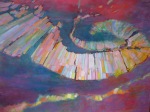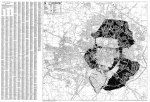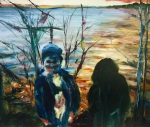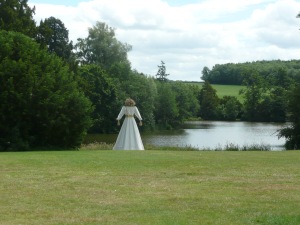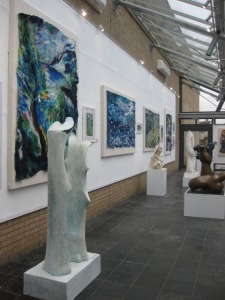As I take a rest before throwing myself bravely into a new year of trying to balance a wine glass, note book and pen at exhibition openings, there’s time to reflect on a year of varied shows – and meeting two gallery bosses called Kate who really suffer for their art.
In July, a retrospective exhibition by Coventry-based artist Nancy Upshall was my first experience of the Deasil Art Gallery in Oxford Street in Leamington. I talked to Nancy about her artistic career and paintings made in Coventry from the 1950s onwards, and also Kate Livingston and Kate Bramwell who run it.
Openings at Deasil are always fun, and Kate B welcomed me to one, when she had her hands full, by inviting me to pour my own Prosecco and “fill it to the brim” – a girl after my own heart. The exhibitions I’ve enjoyed the most have been Nancy’s and also Inked Palette, which brought a new audience to the gallery, as it showed works by people who normally work as tattoo artists. The two Kates really showed their commitment to their work at that exhibition, as each got a tattoo live at the opening – I’m glad to say I’d left by that point, though Kate B has an artist’s palette on her abdomen and Kate L a letter on her leg as a memento of it!
Earlier in the year, Gallery 150 bowed out of its central space in Leamington after Englandia, an exhibition by former Coventry University lecturer John Yeadon, an investigation into England’s national identity which John said doesn’t exist. I met up again with John at the Hunger Meal at Coventry Cathedral, organised by Artspace’s City Arcadia project, where we were among the naughty children, including Dean John Whitcombe, who didn’t join the organised conversations, but still enjoyed the talk and food enormously.
Rugby Art Gallery started the year in uncertain silence, with the Rugby Collection making an earlier than normal showing, including some new additions to the collection. Its later Open, fairly predictably inspired by the Rugby World Cup, was a bit disappointing but The Gain Line by Ravi Deepres was a mesmerising film which held my attention thoroughly, partly through merging local scenes from the town with a game at a huge venue.
The Mead Gallery at the University of the Warwick began the year with some fascinating Russian photographs from the early twentieth century, and by five contemporary photographers. And, not usually a huge fan of film installations, I was blown away by The Unfinished Conversation, a three-screen installation by John Akomfrah about cultural theorist Prof Stuart Hall. The summer exhibition focused on the Mead’s own collection, now in its 50th year. It was an excellent chance to see together works which are generally spread around the university.
I was also lucky enough, on a beautiful bright day, to be invited to the installation of a new work by David Nash at the University of Warwick’s Diamond Wood, accessible from the Coventry to Kenilworth cycle route and walkway. I talked to the artist as the work was painstakingly winched into place and David positioned it down to the last millimetre. It’s called Habitat and the idea is that local wildlife such as bats, birds and insects will use it; I must return to see how it’s bedded in.
The Mead’s final exhibition of the year, Making it: Sculpture in Britain 1977-1986 was a thorough and educational exhibition about the works in this period, but my overwhelming feeling afterwards was that this wasn’t the most interesting period of sculpture by a long way.
Nuneaton’s Museum & Art Gallery does a valiant job in staging two or three exhibitions at the same time, and it continued to show some small and interesting ones this year, including some inspired by works left to the museum. It started the year with an exhibition of miniatures, which revealed some lovely works by Lady Stott, who’d lived an interesting life. A later exhibition of works by Jhinuk Sarkar was inspired by a collection of items owned by Canon John Turner during his time as a missionary in Baffin Island early last century. It’s amazing where these things end up. Other good shows there this year included urban landscapes of Coventry, Nuneaton and Senegal painted by Sarah Moncrieff, and cartoons by Nuneaton-born professional cartoonist Noel Ford.
The White Room in Leamington continued to lay on fun opening nights, packing people, wine and nibbles into the small but perfectly formed gallery space.
The Lanchester Gallery had been in the prominent and easily accessible spot on a corner in Jordan Way in Coventry for the last couple of years, and flockOmania, which combined giant jewellery and performance, was one of the oddest. It’s a shame it’s now back inside the far less accessible art school building on the corner of Cox Street.
The RSC in Stratford continued to surprise with some good exhibitions, including one about Bruce Bairnsfather, the Warwickshire-born wartime cartoonist I had never heard of but was fascinated to learn about.
Works by Jade Blackstock, Michael Carr and Jennifer Shufflebotham in New Art West Midlands.
New Art West Midlands was challenging, not least to me when I found myself shut outside Birmingham Art Gallery & Museum desperate to get in early before a drive to Colchester (don’t ask). Thankfully PR Helen Stallard rescued me and it turned into a fun opening, with chats to several lovely artists including Michael Carr who I kept running to at exhibitions throughout the year.
Compton Verney had what felt like a good year, starting with an exhibition entitled Canaletto: Celebrating Britain, which showcased his paintings from 1746-55, and I was glad to have attended the official opening and heard gallery director Dr Stephen Parissien put them in their artistic, social and historical context.
Warwickshire-based artist Faye Claridge’s Kern Baby was on show outside all season, a five metre-high faceless, gowned creature, inspired by some Benjamin Stone photographs, with some of her admittedly “edgy” photos inside. I described Kern Baby at the time as looking as though she’d escaped from the building. Months later I visited to find her down by the lake; apparently her prominent position – great as an art work – didn’t go down so well with the venue’s wedding business and photo opportunities.
Kern Baby’s second position, by the lake.
The Chinese Collection enjoyed a big revamp after winning funding, and it made a huge difference, showing the importance of the collection rather than just being on a route between galleries.
Leamington Art Gallery & Museum held A Leamington Lad brought together lots of works by Terry Frost, 100 years after his birth in the town. It was brought to life by some recordings of interviews with the characterful Frost. Later in the year I chanced upon another Frost exhibition in Banbury, Frost, Family and Friends, showing works loaned by individuals rather than galleries, and the often personal stories behind them. The works were mostly smaller and not all in Frost’s usual style, which made it fascinating; it’s on until January 9 so there’s still time to see it.
Recording Britain at The Herbert was a V&A touring exhibition which showed the country in 1939 captured by artists of the time, and many lost scenes were recorded; it was poignant though that not all were lost in the war, some were drowned under reservoirs or lost as industries declined. The autumn season of remembrance at the Herbert included work by contemporary artists, but seeing John Piper’s paintings of the city the day after the Blitz were most memorable.
Away from my usual round of galleries, there were some other gems.
A photographic exhibition at the Belgrade Theatre showed the works of a class of 11 adults studying for City and Guild Level 2 Photography & Photo Imaging at City College, and included some really good works on the theme of city life.
A skateboarder by Tony Skipper in the Belgrade Theatre exhibition, and a John Blakemore from Imagine Hillfields.
Imagine Hillfields was an exhibition which came from a research project, and brought together works by contemporary and historic photographers depicting Hillfields. Jason Tilley had created new portraits for it, Richard Sadler had documented his grandmother’s life in the 50s and Masterji had documented South East Asian families through the decades; but the most astonishing, by John Blakemore from the 1960s hadn’t been seen before. The bleakness of some of the images was at odds with the fizz-fuelled and fun opening.
Lucy Cash presented a film installation in Gosford Books in Coventry city centre as part of the Dance and Somatic Practices Conference 2015 which was being held in the city; about two people could squeeze in to view it at a time.
In the Michael Heseltine Gallery at Middleton Cheney near Banbury, Coventry artist George Wagstaffe, known for his sculptures, held his first painting exhibition at the age of 80-plus, and it was interesting to hear about how Pre-Raphaelite women he’d seen in paintings in Birmingham around the time of the Second World War were influencing him still.
I discovered CRW Nevinson at the Barber in Birmingham, and loved his attitudes and mix of futurist and cubist styles; the gallery showed German Expressionist prints at the same time, works which were derided by the Nazis and can be appreciated now for their honesty and power. On London visits, I discovered and enjoyed the art galleries at the Imperial War Museum.
My first visit to Bilston Craft Gallery was to see Bilston’s Happy Housing: Otto Neurath’s Vision for Post-War Modern Living, an examination of the plan for homes that would actually make people happy, and what happened to that inspirational idea.
There was an exhibition of photographs as part of Coventry University Romani Week in April, with an introductory talk by the late Deputy Council Leader Phil Townshend, who spoke passionately about the city’s dedication to community cohesion.
On a trip to Cornwall, I was amused to find lots of koans (you know, the pointy thing in front of the Warwick Arts Centre) on show at the Tate St Ives as part of a show of Liliane Lijn’s works. I didn’t get to London often this year but was very glad to make it to Ai Weiwei’s exhibition at the Royal Academy; I had thought he was more interesting as a person and campaigner than artist, but seeing lots of his pieces together made me revise that view – the personal and the political merge to create really great works. An exhibition of portraiture by Giacometti found me also having to look anew at works more on paper than in clay by one of my favourite sculptors.
One of the oddest art experiences of the year was the Art Trail run as part of the Earlsdon Festival, where I paced the streets looking for some elusive art works. It was something I felt could grow and be improved upon in 2016, but with the Earlsdon Festival now not happening perhaps it won’t go ahead at all.
Anyway – thanks for the art, the laughs and the gossiping in gallery corners this year – and looking forward to what 2016 will have to offer!
